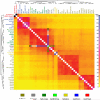The 5300-year-old Helicobacter pylori genome of the Iceman
- PMID: 26744403
- PMCID: PMC4775254
- DOI: 10.1126/science.aad2545
The 5300-year-old Helicobacter pylori genome of the Iceman
Abstract
The stomach bacterium Helicobacter pylori is one of the most prevalent human pathogens. It has dispersed globally with its human host, resulting in a distinct phylogeographic pattern that can be used to reconstruct both recent and ancient human migrations. The extant European population of H. pylori is known to be a hybrid between Asian and African bacteria, but there exist different hypotheses about when and where the hybridization took place, reflecting the complex demographic history of Europeans. Here, we present a 5300-year-old H. pylori genome from a European Copper Age glacier mummy. The "Iceman" H. pylori is a nearly pure representative of the bacterial population of Asian origin that existed in Europe before hybridization, suggesting that the African population arrived in Europe within the past few thousand years.
Copyright © 2016, American Association for the Advancement of Science.
Figures




References
-
- Suerbaum S, Josenhans C. Helicobacter pylori evolution and phenotypic diversification in a changing host. Nat. Rev. Microbiol. 2007;5:441–452. - PubMed
-
- Malfertheiner P, Chan FK, McColl KE. Peptic ulcer disease. Lancet. 2009;374:1449–1461. - PubMed
-
- Peek RM, Blaser MJ. Helicobacter pylori and gastrointestinal tract adenocarcinomas. Nature reviews. Cancer. 2002;2:28–37. - PubMed
-
- Falush D, et al. Traces of human migrations in Helicobacter pylori populations. Science. 2003;299:1582–1585. - PubMed
-
- Moodley Y, Linz B. Helicobacter pylori Sequences Reflect Past Human Migrations. Genome Dynamics. 2009;6:62–74. - PubMed
Publication types
MeSH terms
Substances
Grants and funding
LinkOut - more resources
Full Text Sources
Other Literature Sources
Medical
Molecular Biology Databases
Miscellaneous

